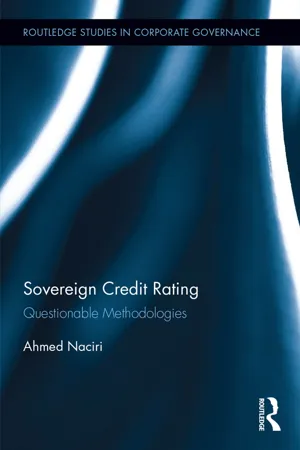Economics
Debt Default
Debt default occurs when a borrower fails to make scheduled payments on a debt, such as a loan or bond. This can lead to serious consequences, including damage to the borrower's credit rating, legal action by the lender, and potential financial instability. In the context of sovereign debt, default can have widespread economic implications for the country and its creditors.
Written by Perlego with AI-assistance
Related key terms
4 Key excerpts on "Debt Default"
- eBook - ePub
Sovereign Debt
From Safety to Default
- Robert W. Kolb(Author)
- 2011(Publication Date)
- Wiley(Publisher)
PART III Sovereign Defaults, Restructurings, and the Resumption of BorrowingAs we have already noted, the history of sovereign debt includes many episodes of default. Some nations have proven to be serial defaulters. Some observers have expressed amazement that a defaulting nation can secure repeated loans. This section examines the problem of defaults in detail. It begins by considering the reasons that nations default and also considers the means that their creditors use to command repayment. Furthermore, it asks the question of whether sovereign defaulters really are punished.Few defaults are simple defaults with a total refusal ever to repay anything. Instead, a much more customary procedure is for the lender and borrower to agree to a rescheduling of the original obligation with reduced payment amounts stretched over a longer repayment horizon. In many instances, international financial institutions, such as the International Monetary Fund, intervene and assist in the restructuring process. While defaulting nations may be excluded from borrowing for some period after a default, this section also considers the conditions under which defaulting nations can reenter the market and secure new financing.Passage contains an image Chapter 15 Understanding Sovereign Default Juan Carlos Hatchondo
Economist, the Federal Reserve Bank*Leonardo Martinez Economist, the IMF Institute Horacio Sapriza Research Economist, Division of International FinanceThis chapter discusses the economics of sovereign defaults, summarizing lessons from existing work on this issue.1 First, we define sovereign defaults. Second, we describe costs of defaulting. Third, we identify circumstances that are likely to lead to a default. Finally, we discuss how default risk may help to account for distinctive features of emerging economies.SOVEREIGN DEFAULTSSovereign debt refers to debt incurred by governments. Sovereign borrowing can be a key policy tool to finance investment or to respond to a cyclical downturn. There are different definitions of a sovereign default. From a legal point of view, a default event is an episode in which a scheduled debt service is not paid beyond a grace period specified in the debt contract. Credit-rating agencies consider a technical default an episode in which the sovereign makes a restructuring offer that contains terms less favorable than the original debt.2 - eBook - ePub
Sovereign Credit Rating
Questionable Methodologies
- Ahmed Naciri(Author)
- 2016(Publication Date)
- Routledge(Publisher)
The link between public default and sovereign economic crisis can become more evident from many sovereign default experiences, or even from the last European sovereign crisis and from the fact that since the beginning of the nineteenth century, most sovereign defaults have occurred because of unexpected turn of economic or social events. It is argued, for instance, that starting in 2009, reports of bad news regarding the sustainability of public debt in Greece, Italy and Portugal undermined the banking sectors in these countries (Gennaioli et al., 2015), as national banks were suddenly exposed to their governments’ bonds. Logically, sovereigns should have strong incentives to repay their debt, even if only to escape foreign sanctions and/or exclusion from the international global markets. But sanctions are rarely observed and market exclusions can only be of short duration. Therefore, the relatively low frequency of defaults should have other explication, and it is argued, for instance, that the huge cost on the domestic economy that might be imposed by default is perhaps dissuading governments to repay their debts, at least in part (Arellano, 2008). The Russian default of 1998, for instance, caused a lot of harm to the Russian economy, particularly to Russian banks that were heavily investing in public bonds, and the banking crisis ended up precipitating the devaluation of the rouble and the rapid collapse of whole Russian financial sector. As a rule, defaults, however, can be very painful for defaulting countries, in at least two ways, particularly when financial inabilities are occurring unexpectedly and in a disorderly manner:- (i) When investor and local savers, anticipating a decline in the value of the local currency, may strive to withdraw their bank account deposits and move them out of the troubled countries, eventually forcing troubled governments to temporarily shutting down banks and imposing capital controls, as the only way to avoid bank runs and precipitous currency depreciation, as happened in Greece in mid-2015. Often, however, such desperate reactions only exacerbate crisis.
- (ii) Whenever sovereign defaulters find themselves submitted to capital market punishment for their default, either by imposition of punitive borrowing conditions or by opposed plea to all their indebtedness demands. Indeed, it seems that on average defaulted sovereign governments remain out of international capital markets for as long as 5.6 years after default and 4.4 years after final default resolution and 45 per cent of defaulters never regained market access during the study period (Moody’s, 2015).
- eBook - ePub
- Johnna Montgomerie(Author)
- 2019(Publication Date)
- Polity(Publisher)
When we think about the problems (or the harm) that debt causes, these are both ‘big-picture’ economic problems and ‘small-scale’ personal ones, because debt is a social force acting upon people. We can see the impact of the debt economy in the harm inflicted on people by the 2008 financial crisis and by the ensuing period of austerity, which continues into the present day. The debt economy is in a vice grip of countervailing forces. The forces of personally experienced indebtedness are refracted onto the national economy and from there onto the global financial system.Debt has so many entanglements in everyday life that there is no path out of the financial crisis that will not induce yet another financial crisis, bound to create new forms of harm and insecurity. For example, if every person struggling with debt decided to pay down their debts, the national economy would be plunged into depression, the global economy following closely behind. However, if every person struggling with debt continues to take on more debt to maintain his or her standard of living, soon there will be rising insolvency rates. Currently most households keep up their debt repayments. However, by doing so, they are robbing the economy of its vitality by regularly remitting a growing portion of their present-day income to pay debts that have fuelled past economic activity: these payments are thousands of small pinpricks that bleed the economy, and these are the underlying cause of the entrenched economic malaise in Anglo-America. If, or when, for whatever reason, the same people who are today able to service their debts become unable to make these regular repayments, a worse scenario unfolds. Rising default rates on any one of the many types of loans that households have add to the portfolio of non-performing loans on bank balance sheets.As the 2008 financial crisis revealed, the elaborate network of financial claims flowing through the global financial system is vulnerable to default on even small-scale retail loans, as exemplified in the United States subprime mortgage loans. Rising default rates on a small portfolio of retail loans would, once again, set off sparks that could light another fire storm that will blaze across global markets. The threat of another financial crisis looms large, but living in fear of another economic catastrophe is not a successful way of governing or organizing the economy and society. - eBook - ePub
- Ensar Yılmaz(Author)
- 2020(Publication Date)
- Routledge(Publisher)
2Debt accumulation
2.1 IntroductionEconomists generally regard debt as a beneficial instrument that allows money to move from where it is least needed to where it is most needed by borrowers. Hence the deepening of national and international credit markets is thought to increase growth, since it makes it possible for more individuals to borrow from a bigger loan market at appropriate rates of interest. However, whenever a financial crisis occurs, debt turns out to be a problem, thus turning from a ladder into a chute. Hence in recent years the dynamics of debt and its relation with crises has become a much more important issue of economics.During the global crisis period that started in 2007, a large number of defaults on mortgages occurred in the US. Financial institutions, especially investment banks, could not bear these defaults. Along with the contagion of defaults, banks with liquidity problems could not continue to lend, hence it spreading to the rest of the economy. Governmental rescues increased public debt as well. This also caused fears to spread about the solvency of sovereign debts of some countries in Europe, ending with Greece’s collapse. Therefore, debt seems to have been both a cause and an outcome of the crisis.However, until the Global Recession, in the mainstream economic models, debt was not regarded as an issue that could trigger a sequence of problems, hence it was not incorporated into these models. The main rationale behind this was that borrowers and lenders canceled each other out at the level of the economy, thus every dollar owed by someone was also owed to someone. Hence the incorporation of debt into economic analysis seemed trivial. However, we learn each time from austere times (during crises) that debt is critical in terms of triggering the problems and their deepening. Therefore, debt is a more complex issue and not a simple zero-sum game. Economists have started to deal with new complications by including debt in their economic models such as heterogeneity between debtors and creditors and discontinuity arising from collapse in economic relations.
Learn about this page
Index pages curate the most relevant extracts from our library of academic textbooks. They’ve been created using an in-house natural language model (NLM), each adding context and meaning to key research topics.



